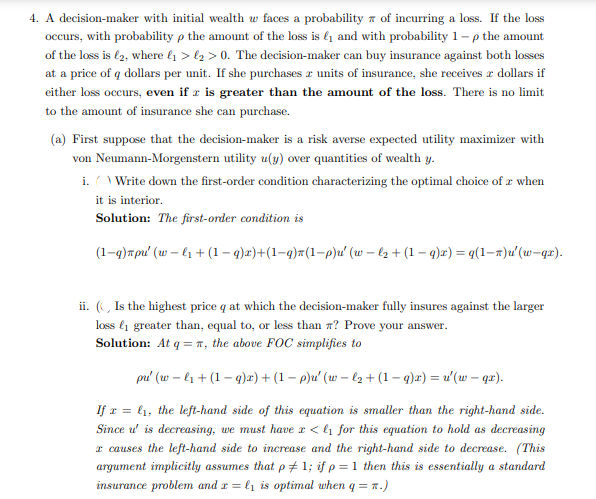A decision-maker with initial wealth w faces a probability of incurring a loss. If the loss occurs, with probability p the amount of the loss is ₁ and with probability 1-p the amount of the loss is £2, where ₁>₂ > 0. The decision-maker can buy insurance against both losses at a price of q dollars per unit. If she purchases z units of insurance, she receives z dollars if either loss occurs, even if z is greater than the amount of the loss. There is no limit to the amount of insurance she can purchase. (a) First suppose that the decision-maker is a risk averse expected utility maximizer with von Neumann-Morgenstern utility u(y) over quantities of wealthy. i. (Write down the first-order condition characterizing the optimal choice of z when it is interior. Solution: The first-order condition is (1−q)ñpu² (w − l₁ + (1 − g)x)+(1−g)x(1−p)u' (w − l₂ + (1 − g)x) = g(1−z)u'(w—qx). ii. (, Is the highest price q at which the decision-maker fully insures against the larger loss ₁ greater than, equal to, or less than ? Prove your answer. Solution: Atq=, the above FOC simplifies to pu' (w-l₁ + (1-9)x) + (1 − p)u' (w − l₂ + (1 − q)x) = u(w − qr). I If z = {₁, the left-hand side of this equation is smaller than the right-hand side. Since u' is decreasing, we must have r
A decision-maker with initial wealth w faces a probability of incurring a loss. If the loss occurs, with probability p the amount of the loss is ₁ and with probability 1-p the amount of the loss is £2, where ₁>₂ > 0. The decision-maker can buy insurance against both losses at a price of q dollars per unit. If she purchases z units of insurance, she receives z dollars if either loss occurs, even if z is greater than the amount of the loss. There is no limit to the amount of insurance she can purchase. (a) First suppose that the decision-maker is a risk averse expected utility maximizer with von Neumann-Morgenstern utility u(y) over quantities of wealthy. i. (Write down the first-order condition characterizing the optimal choice of z when it is interior. Solution: The first-order condition is (1−q)ñpu² (w − l₁ + (1 − g)x)+(1−g)x(1−p)u' (w − l₂ + (1 − g)x) = g(1−z)u'(w—qx). ii. (, Is the highest price q at which the decision-maker fully insures against the larger loss ₁ greater than, equal to, or less than ? Prove your answer. Solution: Atq=, the above FOC simplifies to pu' (w-l₁ + (1-9)x) + (1 − p)u' (w − l₂ + (1 − q)x) = u(w − qr). I If z = {₁, the left-hand side of this equation is smaller than the right-hand side. Since u' is decreasing, we must have r
Chapter7: Uncertainty
Section: Chapter Questions
Problem 7.4P
Related questions
Question
please only do: if you can teach explain steps of how to solve each part
what is the optimizatio formula that was use for foc? please solve
each part

Transcribed Image Text:4. A decision-maker with initial wealth w faces a probability of incurring a loss. If the loss
occurs, with probability p the amount of the loss is ₁ and with probability 1-p the amount
of the loss is £2, where ₁ > ₂ > 0. The decision-maker can buy insurance against both losses
at a price of q dollars per unit. If she purchases a units of insurance, she receives a dollars if
either loss occurs, even if z is greater than the amount of the loss. There is no limit
to the amount of insurance she can purchase.
(a) First suppose that the decision-maker is a risk averse expected utility maximizer with
von Neumann-Morgenstern utility u(y) over quantities of wealth y.
i. () Write down the first-order condition characterizing the optimal choice of a when
it is interior.
Solution: The first-order condition is
(1-q)πpu' (w-l₁ + (1 − q)x)+(1−q)π(1−p)u' (w − l₂ + (1 — q)x) = q (1-7)u' (w-qx).
ii. (, Is the highest price q at which the decision-maker fully insures against the larger
loss ₁ greater than, equal to, or less than ? Prove your answer.
Solution: At q = n, the above FOC simplifies to
pu' (wl₁ + (1-q)x)+ (1 − p)u' (w−l₂ + (1 − q)x) = u'(w — qx).
If x= ₁, the left-hand side of this equation is smaller than the right-hand side.
Since u' is decreasing, we must have x < ₁ for this equation to hold as decreasing
x causes the left-hand side to increase and the right-hand side to decrease. (This
argument implicitly assumes that p1; if p = 1 then this is essentially a standard
insurance problem and r = l₁ is optimal when q = n.)
Expert Solution
This question has been solved!
Explore an expertly crafted, step-by-step solution for a thorough understanding of key concepts.
Step by step
Solved in 3 steps with 2 images

Knowledge Booster
Learn more about
Need a deep-dive on the concept behind this application? Look no further. Learn more about this topic, economics and related others by exploring similar questions and additional content below.Recommended textbooks for you


Brief Principles of Macroeconomics (MindTap Cours…
Economics
ISBN:
9781337091985
Author:
N. Gregory Mankiw
Publisher:
Cengage Learning

Essentials of Economics (MindTap Course List)
Economics
ISBN:
9781337091992
Author:
N. Gregory Mankiw
Publisher:
Cengage Learning


Brief Principles of Macroeconomics (MindTap Cours…
Economics
ISBN:
9781337091985
Author:
N. Gregory Mankiw
Publisher:
Cengage Learning

Essentials of Economics (MindTap Course List)
Economics
ISBN:
9781337091992
Author:
N. Gregory Mankiw
Publisher:
Cengage Learning

Principles of Economics 2e
Economics
ISBN:
9781947172364
Author:
Steven A. Greenlaw; David Shapiro
Publisher:
OpenStax